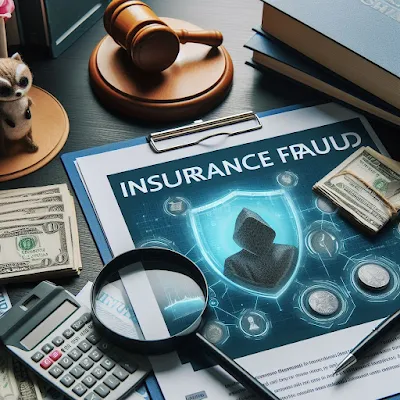Insurance Fraud: Recognizing and Avoiding Common Scams
Insurance fraud is a pervasive issue affecting both insurers and policyholders. As technology advances, so do the methods used by fraudsters to deceive the system. It's crucial for individuals and businesses to be aware of common insurance scams, recognizing the red flags and taking preventive measures to avoid falling victim to fraudulent activities.
The Scope of Insurance Fraud
Insurance fraud takes various forms, ranging from exaggerated claims and staged accidents to elaborate schemes involving multiple parties. These fraudulent activities contribute to increased premiums for everyone and undermine the integrity of the insurance industry.
Understanding Fraudulent Claims
One of the most common types of insurance fraud involves policyholders submitting false or inflated claims. This can include exaggerating the extent of damages in a car accident, inflating the value of stolen items, or even fabricating incidents that never occurred.
Staged Accidents and Collisions
Staged accidents are a prevalent form of fraud, often involving multiple individuals who collaborate to create a fake collision. Fraudsters may orchestrate accidents to claim damages, injuries, and medical expenses, leading to fraudulent insurance payouts.
Identity Theft and Insurance
Identity theft is another avenue for insurance fraud. Fraudsters may use stolen identities to purchase insurance policies, file false claims, or even stage accidents. Vigilance in protecting personal information is essential to prevent falling victim to such scams.
Read More: Beyond Basics: Specialized Insurance for Unique Needs
Healthcare Fraud: False Medical Claims
Health insurance is susceptible to fraud through false medical claims. This can involve billing for services that were not provided, inflating costs, or submitting claims for fictitious treatments. It's essential for individuals to review medical statements carefully and report any discrepancies.
Home Insurance Schemes
Homeowners may encounter insurance fraud through schemes such as arson or property damage exaggeration. Fraudsters may intentionally damage property to file a claim, leading to inflated payouts that impact insurance premiums for all policyholders.
Auto Insurance Scams
Auto insurance scams are diverse and can include activities like fake accidents, vehicle theft conspiracies, or false injury claims. Vigilance on the road, obtaining accurate information after accidents, and reporting suspicious activities are crucial in combating auto insurance fraud.
Insurance Agent and Broker Fraud
While most insurance professionals operate with integrity, some may engage in fraud, including selling fake policies, embezzling premiums, or providing misleading information to policyholders. Verifying the credentials of insurance agents and brokers is vital to avoid falling victim to scams.
Red Flags: How to Recognize Insurance Fraud
Recognizing red flags is essential in identifying potential insurance fraud. Unusual claim patterns, frequent claims, inconsistent information, or reluctance to provide details are warning signs that should prompt further investigation.
Surveillance and Investigative Techniques
Insurers employ surveillance and investigative techniques to identify fraudulent activities. This can include analyzing data, conducting interviews, and using advanced technology to verify the authenticity of claims. These measures help insurers detect and prevent fraud, protecting the integrity of the insurance system.
Preventing Insurance Fraud
Preventing insurance fraud requires a collaborative effort between insurers, law enforcement, and policyholders. Insurers invest in anti-fraud technologies, conduct thorough investigations, and collaborate with authorities to prosecute fraudsters. Policyholders can contribute by staying informed, reporting suspicious activities, and being cautious in their interactions with insurance providers.
Educating Policyholders
Education is a powerful tool in the fight against insurance fraud. Insurers can play a proactive role by educating policyholders about common scams, warning signs, and steps to take if they suspect fraudulent activities. Awareness empowers individuals to protect themselves and the broader insurance community.
Whistleblower Protection
Whistleblower protection is crucial in encouraging individuals to come forward with information about potential fraud. Insurers and authorities should provide a safe and confidential mechanism for reporting suspicious activities, fostering a culture of accountability in the insurance industry.
Legislation and Legal Measures
Strong legislation and legal measures are essential in deterring and penalizing insurance fraud. Authorities must have the tools to prosecute fraudsters effectively, imposing fines, penalties, and even imprisonment for those found guilty of engaging in fraudulent activities.
Technological Solutions: Artificial Intelligence and Data Analytics
Advancements in technology, such as artificial intelligence and data analytics, are instrumental in combating insurance fraud. Insurers leverage these tools to analyze vast amounts of data, detect patterns, and identify anomalies that may indicate fraudulent behavior.
Consumer Reviews and Reputation Management
Consumers can protect themselves by researching insurance providers, reading reviews, and considering the reputation of companies before purchasing policies. Reliable insurers with transparent practices are less likely to engage in fraudulent activities, ensuring a more secure and trustworthy insurance experience.
Conclusion: Building a Fraud-Resistant Insurance Environment
In conclusion, recognizing and avoiding common insurance scams is vital in building a fraud-resistant insurance environment. With collaborative efforts from insurers, authorities, and vigilant policyholders, the industry can continue to evolve and adapt to emerging threats, ensuring the integrity and sustainability of the insurance system for all.

